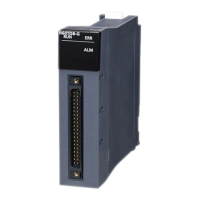7 APPLICATION INSTRUCTIONS
7.8 String Processing Instructions
643
7
• These instructions convert the digit in decimal notation of the 16-bit binary data in the device specified by (s) to the ASCII
code, and store the converted data in the device number specified by (d) and later.
• The format of the decimal ASCII data to be stored in (d) depends on the status of SM705 (Number of conversion digits
selection).
*1 For the firmware version of the CPU module supporting SM705, refer to the following.
MELSEC iQ-R CPU Module User's Manual (Application)
A CPU module which does not support SM705 operates in the same way as SM705 is off even if it is turned on.
■Operation overview
The following figure shows the operation when SM705 (Number of conversion digits selection) is off and on.
When the BINDA(P) instruction is executed with the numeric value "-12" stored in (s)
• When SM705 is off, the number of digits is fixed. The first character is a sign and it is 2DH(-) in the above example. (If (s) is
0 or positive, the first character is 20H (space).) The numeric part is right-justified. When the length of the numeric part is
less than 5 digits, the ASCII code 20H (space) is stored for the ASCII code of the upper digit(s).
• When SM705 is on, data is left-justified. When the length of the numeric part is less than 5 digits, 00H is stored in the end.
Status of SM705
*1
Storage format of (d) Reference
OFF Data is stored in a fixed number of digits (a sign + 5 digits) Page 644 Operation of when SM705 (Number of
conversion digits selection) is off
ON Each digit is stored left-justified depending on the value of (s). Page 644 Operation of when SM705 (Number of
conversion digits selection) is on
b15 b0
-12(s) BINDA(P)
SM705: OFF
b15 b0
20H 2DH(d)+0
-21SPSPSP
20H 20H(d)+1
32H 31H(d)+2
b15 b0
31H 2DH(d)+0
- NULL21
00H 32H(d)+1
(d)+2
SM705: ON

